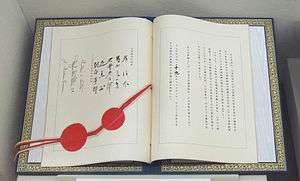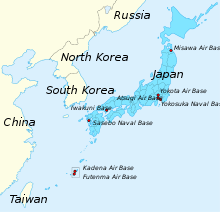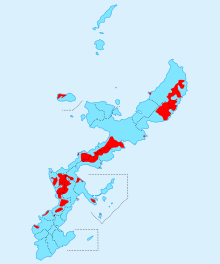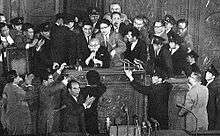Treaty of Mutual Cooperation and Security Between the United States and Japan
The Treaty of Mutual Cooperation and Security between the United States and Japan (日本国とアメリカ合衆国との間の相互協力及び安全保障条約, Nihon-koku to Amerika-gasshūkoku to no Aida no Sōgo Kyōryoku oyobi Anzen Hoshō Jōyaku), also known in Japan as Anpo jōyaku (安保条約) or just Anpo (安保) for short,[1] is a treaty establishing a military alliance between the United States and Japan. The treaty was first signed in 1951 at the San Francisco Presidio after the signing of the Treaty of San Francisco (commonly known as the Peace Treaty of San Francisco) at the San Francisco War Memorial Opera House. Then, the Security Treaty was amended further in January 1960 between the US and Japan in Washington, DC.
Long name:
| |
|---|---|
 Treaty signature page (Japanese-language copy) | |
| Type | Military Alliance |
| Signed | 19 January 1960 |
| Location | Washington, D.C. |
| Effective | 19 May 1960 |
| Parties | |
| Citations | 11 U.S.T. 1632; T.I.A.S. No. 4509 |
| Language | English, Japanese |
When the treaty was first signed, it contained provisions that permitted the United States to act to maintain peace in East Asia and even to exert its power on Japanese domestic quarrels. The latter part mentioned has been deleted in the revised version of the treaty. In the amended treaty, articles that delineate mutual defense obligations and the US obligations to inform Japan before US forces mobilized were included to alleviate unequal status suggested in the 1952 treaty.[2]
The treaty established that any attack against Japan or the United States perpetrated within Japanese territorial administration would be dangerous to both countries' peace and safety. It required both countries to act to meet the common danger. To support that requirement, it provided for the continued presence of US military bases in Japan.
The treaty also included general provisions on the further development of international cooperation and improved future economic cooperation.[3]
The treaty has lasted longer than any other alliance between two great powers since the 1648 Peace of Westphalia.[4] The treaty had a minimum term of 10 years but provided that it would remain in force permanently unless one party gives one year's notice of wishing to terminate it.
Background


The earlier Security Treaty of 1951 provided the initial basis for the Japan's security relations with the United States and was signed after Japan had regained full sovereignty at the end of the allied occupation.
Bilateral talks on revising the 1951 treaty began in 1959, and the new Treaty of Mutual Cooperation and Security was signed in Washington on 19 January 1960. When the pact was submitted to the Japanese Diet for ratification on February 5, it became the subject of bitter debate over Japanese-American relations and the occasion for violence in an all-out effort by leftists to prevent its passage. The treaty was finally approved by the Japanese House of Representatives on 20 May. Japan Socialist Party deputies boycotted the lower house session, tried to prevent the Liberal Democratic Party deputies from entering the chamber, and were forcibly removed by the police. Massive demonstrations and rioting by students and trade unions followed. The outbursts prevented a scheduled visit to Japan by US President Dwight D. Eisenhower and precipitated the resignation of Japanese Prime Minister Nobusuke Kishi but not before the treaty had passed by default on June 19, when the House of Councillors failed to vote on the issue within the required 30 days after the House of Representatives had approved the treaty. Opposition was largely based on the argument that Article 6 of the treaty threatens the sovereign power of Japan since, as further explained below, it contains a Status of Forces Agreement that allows the US to use military forces and facilities deployed in Japan for combat other than for the defense of Japan.
Terms
In Article 1, the treaty began by establishing that each country would seek to resolve any international disputes peacefully. The treaty also gave prominence to the United Nations in dealing with aggression.
Article 5, which dealt with armed attacks by a third party, required for the UN Security Council to be involved and that any measures taken by the US and Japan to be ceased "when the Security Council has taken the measures necessary to restore and maintain international peace and security." Also, Article 10 allowed for the abrogation of the treaty if both parties agreed that the United Nations has made satisfactory arrangements to provide for the stability of peace and security in the Japan area: if and when the system of collective security went into effect.
Under the treaty, both parties assumed an obligation to maintain and to develop their capacities to resist armed attack in common and to assist each other during armed attack on territories under Japanese administration. It was understood, however, that Japan could not come to the defense of the United States because it was constitutionally forbidden to send armed forces overseas by Article 9 of the Constitution of Japan, which forbids the maintenance of "land, sea, and air forces" and expresses the Japanese people's renunciation of "the threat or use of force as a means of settling international disputes." The scope of the new treaty did not extend to the Ryukyu Islands, but an appended minute clarified that during an armed attack on the islands, both governments would consult and take appropriate action.
Unlike the 1951 security pact, the new treaty provided for a ten-year term after which it could be revoked upon one year's notice by either party.
Article 6 of the treaty contained a Status of Forces Agreement on the stationing of United States Forces Japan, with specifics on the provision of facilities and areas for their use and on the administration of Japanese citizens employed in the facilities.
The agreed minutes to the treaty specified that the Japanese government would be consulted prior to major changes in United States force deployment in Japan or to the use of Japanese bases for combat operations other than to defend Japan itself. Also covered were the limits of both countries' jurisdictions over crimes committed in Japan by US military personnel.
Aftermath
The Mutual Security Assistance Pact of 1954 initially involved a military aid program that provided for Japan's acquisition of funds, materiel and services for the nation's essential defense. Although Japan had no longer received any aid from the United States by the 1960s, the agreement continued to serve as the basis for purchase and licensing agreements ensuring interoperability of both nations' weapons and for the release of classified data to Japan, including international intelligence reports and classified technical information.
There were other widespread protests in Japan when the pact was renewed in 1970, but they died down thereafter.
Further, there was a shift in Japanese domestic politics. Nobusuke Kishi had to resign as prime minister and succumbed to widespread demonstrations against the treaty and the US in general. He was succeeded by Hayato Ikeda.
Opposition
In May and June 1960, mass demonstrations took place outside the Diet building, opposing forced adoption of the revised treaty in 1960. An umbrell organization, People's Council to Stop the Revised Security Treaty (安保条約改定阻止国民会議, Anpo Jōyaku Kaitei Soshi Kokumin Kaigi), co-ordinated the actions of various citizen movements involved in opposing the revision. It formed with 134 organizations as members in March 1959 and grew to have 1,633 affiliated organizations by March 1960. The groups included labor unions, farmers' and teachers' unions, poetry circles, theater troupes, student and women's organizations, mothers' groups, and groups affiliated with the Japan Socialist Party and the Japan Communist Party.[5][6]
A University of Tokyo undergraduate and student activist, Michiko Kanba, died in clashes between protestors and police at the South Gate of the Diet Building in the evening of 15 June 1960.[7]

A central issue in the debate over the continued US military presence is the concentration of troops in the small Japanese prefecture of Okinawa. US military bases cover about one fifth of Okinawa and serve around 75% of the US forces in Japan (Packard, 2010, Sumida, 2009). That has left many Okinawans feeling that the security agreement may be beneficial to the United States and Japan as a whole, but it is burdensome to the residents of the small subtropical island.
Another contentious issue to many Okinawans is the noise and environmental pollution created by the US forces in Japan. Excessive noise lawsuits in 2009 filed by Okinawa's residents against Kadena Air Base and MCAS Futenma resulted in awards of $59 million and $1.3 million to residents, respectively (Sumida, 2009). The tourist attraction of Okinawa's coral reef has suffered from continuous runoff of live fire exercises from the military bases (JCP, 2000). The most powerful opposition in Okinawa, however, stemmed from criminal acts committed by US servicemembers and their dependents, with the latest example being the 1995 kidnapping and molestation of a 12-year-old Okinawan girl by two Marines and a Navy corpsmen (Packard, 2010). In early 2008, US Secretary of State Condoleezza Rice apologized after a series of crimes involving American troops in Japan, including the rape of a girl of 14 by a marine on Okinawa. The US military also imposed a temporary 24-hour curfew on military personnel and their families to ease the anger of local residents.[8] Some media cited statistics that the crime rate of military personnel was consistently less than that of the general Okinawan population.[9]
In a 2006 agreement between the George W. Bush administration and the Japanese government, MCAS Futenma was to be relocated to the northern Okinawa city of Nago, and 8,000 Marines and their dependents were to be relocated to Guam (Packard, 2010). The agreement, however, received very little support from Okinawans. After spending several months deliberating over the new location of the base would move, Yukio Hatoyama conceded to allow the original agreement to go forward and immediately resigned after he stated that he had failed to fulfill one of his promises.
Support
Despite the strong Okinawan opposition to the US military presence on the island, there was also strong support for the agreement. Fear of a new imperialistic Japan made its lawmakers forbid the maintaining of more than a self-defense forces when they drafed the postwar Constitution. As a result, Japan has never spent more than 1% of its GDP on military expenditures (Englehardt, 2010). In return for allowing the US military presence in Japan, the United States agrees to help defend Japan against any foreign adversaries, such as North Korea.
In addition to military support, the military presence in Okinawa contributes to the economy of Japan's poorest prefecture. As of 2004, 8,813 locals worked on bases, in addition to numerous others who worked in shops and bars in which the main customer base is US service members. Altogether, the US presence accounts for about 5% of the Okinawan economy (Fukumura, 2007).
According to a 2007 Okinawa Times poll, 73.4% of Japanese citizens appreciated the mutual security treaty with the US and the presence of US forces.[10]
Coverage
In 2012, the US clarified in a statement over the dispute over the Senkaku Islands that the treaty covers the islands and requires the Americans to defend them.[11]
In April 2014, US President Barack Obama declared unequivocally that the islands would be covered by the treaty in the event of an armed attack on them. That was the first time a sitting US president made an explicit commitment and was intended to reassure the government of Japan.
On 19 April 2019, Japan and the United States confirmed that cyberattacks are also covered by the treaty. Defense co-operation will increase for outer space warfare, cyberwarfare and electronic warfare.[12]
External links
| Wikisource has original text related to this article: |
References
- Ryan Holmberg, "Know Your Enemy: ANPO," Art in America, Jan 2011.
- Gordon, Andrew (2003). A Modern History of Japan: From Tokugawa times to the Present. New York: Oxford University Press.
- http://afe.easia.columbia.edu/ps/japan/mutual_cooperation_treaty.pdf
- Packard, George R. "The United States-Japan Security Treaty at 50". Foreign Affairs. Retrieved 23 April 2013.
- Igarashi, Yoshikuni (2000). Bodies of Memory: Narratives of War in Postwar Japanese Culture, 1945-1970. Princeton University PRess. p. 125.
- Jones, Colin (3 March 2020). "The Protests That Made and Unmade Japan's Postwar Left". ISSN 0027-8378. Retrieved 23 June 2020.
- Hirano, Keiji. "Legacy of 1960 protest movement lives on". Japan Times. Retrieved 8 March 2018.
- Justin McCurry (28 February 2008). "Condoleezza Rice apologizes for US troops behavior on Okinawa as crimes shake alliance with Japan". The Guardian. UK.
- MICHAEL HASSETT (26 February 2008). "U.S. military crime: SOFA so good?The stats offer some surprises in wake of the latest Okinawa rape claim". The Japan Times. Archived from the original on 5 March 2008.
- 自衛隊・防衛問題に関する世論調査 Archived 2010-10-22 at the Wayback Machine, The Cabinet Office of Japan
- "Panetta tells China that Senkakus under Japan-U.S. Security Treaty". THE ASAHI SHIMBUN. 21 September 2012. Retrieved 6 April 2013.
- "US to defend Japan from cyberattack under security pact". The Mainichi. 20 April 2019. Archived from the original on 21 April 2019. Retrieved 21 April 2019.
Sources
| Wikimedia Commons has media related to Treaty of Mutual Cooperation and Security between the United States and Japan. |
- Engelhart, K. (2010). "THE BATTLE FOR OKINAWA". Maclean's, 123(10), 29–30. Retrieved from Academic Search Complete database on 6 August 2010.
- Frank, R. (2010). "The Pacific War's Biggest Battle". Naval History, 24(2), 56–61. Retrieved from Academic Search Complete database 6 August 2010.
- Fukumura, Y. (2007). "Okinawa: Effects of Long-term US Military Presence". Retrieved from genuinesecurity.org on 6 August 2010.
- Japanese Communist Party (February 2000). Problems of U.S. Military Bases in Okinawa Japanese Communist Party".
- Kapur, N. (2018). Japan at the crossroads: Conflict and compromise after Anpo.
- Packard G. (2010). "The United States-Japan Security Treaty at 50". Foreign Affairs :92–103. Retrieved from: Military & Government Collection, August 2, 2010.
- Sumida, Chiyomi (27 November 2009) "Futenma Questions and Answers". Stars and Stripes.
- Sumida, Chiyomi (1 March 2009). "$57 million awarded in Kadena noise suit". Stars and Stripes.
- Sumida, Chiyomi (22 October 2009). "Japan high court hears arguments in Futenma noise pollution lawsuit". Stars and Stripes.
![]()